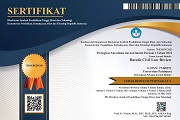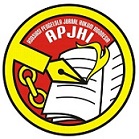Rights and Position of Home Children In The Sanahu Community of West Part of Seram District
 ), Adonia Ivonne Laturette(2), Pieter Radjawane(3)
), Adonia Ivonne Laturette(2), Pieter Radjawane(3)
(1) Faculty of Law Pattimura University, Ambon, Indonesia
(2) Faculty of Law Pattimura University, Ambon, Indonesia
(3) Faculty of Law Pattimura University, Ambon, Indonesia
 Corresponding Author
Corresponding Author
Abstract
Introduction: The offspring of a husband and wife being taken as children for another family, whether close relatives or distant relatives based on an agreement which of course gives rise to the rights and position of the adopted child, for this reason it is necessary to establish the rights and position of the child. so it won't cause problems in the future.
Purposes of the Research: To find out and analyze the rights and position of returning children in the Sanahu Community, West Seram Regency.
Methods of the Research: This research was conducted using an empirical juridical approach which is a descriptive qualitative analysis study. The research attempts to describe the rights and position of returning children in the Sanahu Community, West Seram Regency. The workings of the empirical juridical or sociological juridical method in this research proposal, namely from the results of collecting and discovering data and information through literature study of the basic assumptions or presumptions used in answering the problems in this research, then inductive-verification testing is carried out on the latest facts existing in society.
Results of the Research: The results of the research show that the rights and position of children returning home in the Sanahu Community of West Seram Regency are regulated based on customary rules that developed in Sanahu Village where adopted children will be classified as legitimate children of the parents who adopted them and have the position of biological children so that they have the right to the inheritance of that person. The parents adopted him, but the assets he inherited were only the joint assets of his adoptive parents. The child's inherited assets did not have the right to inherit them.Keywords
DOI
10.47268/ballrev.v4i2.1840
Published
2023-11-14
How To Cite
@article{BALLREV1840,
author = {Barzah Latupono and Adonia Laturette and Pieter Radjawane},
title = {Rights and Position of Home Children In The Sanahu Community of West Part of Seram District},
journal = {Batulis Civil Law Review},
volume = {4},
number = {2},
year = {2023},
keywords = {Position and Rights; Children Returning Home; Indigenous Peoples.},
abstract = {Introduction: The offspring of a husband and wife being taken as children for another family, whether close relatives or distant relatives based on an agreement which of course gives rise to the rights and position of the adopted child, for this reason it is necessary to establish the rights and position of the child. so it won't cause problems in the future.Purposes of the Research: To find out and analyze the rights and position of returning children in the Sanahu Community, West Seram Regency.Methods of the Research: This research was conducted using an empirical juridical approach which is a descriptive qualitative analysis study. The research attempts to describe the rights and position of returning children in the Sanahu Community, West Seram Regency. The workings of the empirical juridical or sociological juridical method in this research proposal, namely from the results of collecting and discovering data and information through literature study of the basic assumptions or presumptions used in answering the problems in this research, then inductive-verification testing is carried out on the latest facts existing in society.Results of the Research: The results of the research show that the rights and position of children returning home in the Sanahu Community of West Seram Regency are regulated based on customary rules that developed in Sanahu Village where adopted children will be classified as legitimate children of the parents who adopted them and have the position of biological children so that they have the right to the inheritance of that person. The parents adopted him, but the assets he inherited were only the joint assets of his adoptive parents. The child's inherited assets did not have the right to inherit them.},
issn = {2746-8151}, pages = {113--118} doi = {10.47268/ballrev.v4i2.1840},
url = {https://fhukum.unpatti.ac.id/jurnal/ballrev/article/view/1840}
}
Arikunto, Suharsimi. Research Procedures A Practice Approach. Jakarta: Rineka Cipta, 2006Hilman Hadikusuma, Customary Marriage Law, Alumni, Bandung, 1990
Mochtar Kusumaatmadja et al, Introduction to Legal Science: A First Introduction to the Scope of Law Application Book I Bandung Alumni 2000
Surojo Wignjodipoero, Introduction and Principles of Customary Law, Gunung Agung, Jakarta, 1983
Sharty Dellyana, Women and Children in the Eyes of the Law, Liberty, Yogyakarta, 1988Zaini, Mudernis. Adoption of a Goal of Three Legal Systems. Jakarta: Sinar Graphics, 2002.
| Dublin Core | PKP Metadata Items | Metadata for this Document | |
| 1. | Title | Title of document | Rights and Position of Home Children In The Sanahu Community of West Part of Seram District |
| 2. | Creator | Author's name, affiliation, country | Barzah Latupono; Faculty of Law Pattimura University, Ambon; Indonesia |
| 2. | Creator | Author's name, affiliation, country | Adonia Ivonne Laturette; Faculty of Law Pattimura University, Ambon; Indonesia |
| 2. | Creator | Author's name, affiliation, country | Pieter Radjawane; Faculty of Law Pattimura University, Ambon; Indonesia |
| 3. | Subject | Discipline(s) | |
| 3. | Subject | Keyword(s) | Position and Rights; Children Returning Home; Indigenous Peoples. |
| 4. | Description | Abstract | Introduction: The offspring of a husband and wife being taken as children for another family, whether close relatives or distant relatives based on an agreement which of course gives rise to the rights and position of the adopted child, for this reason it is necessary to establish the rights and position of the child. so it won't cause problems in the future.Purposes of the Research: To find out and analyze the rights and position of returning children in the Sanahu Community, West Seram Regency.Methods of the Research: This research was conducted using an empirical juridical approach which is a descriptive qualitative analysis study. The research attempts to describe the rights and position of returning children in the Sanahu Community, West Seram Regency. The workings of the empirical juridical or sociological juridical method in this research proposal, namely from the results of collecting and discovering data and information through literature study of the basic assumptions or presumptions used in answering the problems in this research, then inductive-verification testing is carried out on the latest facts existing in society.Results of the Research: The results of the research show that the rights and position of children returning home in the Sanahu Community of West Seram Regency are regulated based on customary rules that developed in Sanahu Village where adopted children will be classified as legitimate children of the parents who adopted them and have the position of biological children so that they have the right to the inheritance of that person. The parents adopted him, but the assets he inherited were only the joint assets of his adoptive parents. The child's inherited assets did not have the right to inherit them. |
| 5. | Publisher | Organizing agency, location | Faculty of Law, Universitas Pattimura |
| 6. | Contributor | Sponsor(s) | |
| 7. | Date | (YYYY-MM-DD) | 2023-11-14 |
| 8. | Type | Status & genre | Peer-reviewed Article |
| 8. | Type | Type | |
| 9. | Format | File format | |
| 10. | Identifier | Uniform Resource Identifier | https://fhukum.unpatti.ac.id/jurnal/ballrev/article/view/1840 |
| 10. | Identifier | Digital Object Identifier | 10.47268/ballrev.v4i2.1840 |
| 11. | Source | Title; vol., no. (year) | Batulis Civil Law Review; Vol 4, No 2 (2023): VOLUME 4 ISSUE 2, NOVEMBER 2023 |
| 12. | Language | English=en | en |
| 13. | Relation | Supp. Files | |
| 14. | Coverage | Geo-spatial location, chronological period, research sample (gender, age, etc.) | |
| 15. | Rights | Copyright and permissions | Copyright: Authors who publish their manuscripts in this Journal agree to the following conditions: 1. The copyright in each article belongs to the author, as well as the right to patent. 2. Authors are able to enter into separate, additional contractual arrangements for the non-exclusive distribution of the journal's published version of the work (e.g., post it to an institutional repository or publish it in a book), with an acknowledgment of its initial publication in this journal. 3. Authors are permitted and encouraged to post their work online (e.g., in institutional repositories or on their website) prior to and during the submission process, as it can lead to productive exchanges, as well as earlier and greater citation of published work. 4. Authors have the right to self-archiving of the article (Author Self-Archiving Policy)
Licence : Batulis Civil Law Review Journal is disseminated based on the Creative Commons Attribution-NonCommercial 4.0 International license terms. This license allows anyone to copy and redistribute this material in any form or format, compose, modify, and make derivatives of this material for any purpose. You cannot use this material for commercial purposes. You must specify an appropriate name, include a link to the license, and certify that any changes have been made. You can do this in a way that is appropriate, but does not imply that the licensor supports you or your use.
|
Copyright (c) 2023 Barzah Latupono, Adonia Ivonne Laturette, Pieter Radjawane

This work is licensed under a Creative Commons Attribution-NonCommercial 4.0 International License.

 : 1586 times
: 1586 times Download : 807 times
Download : 807 times














